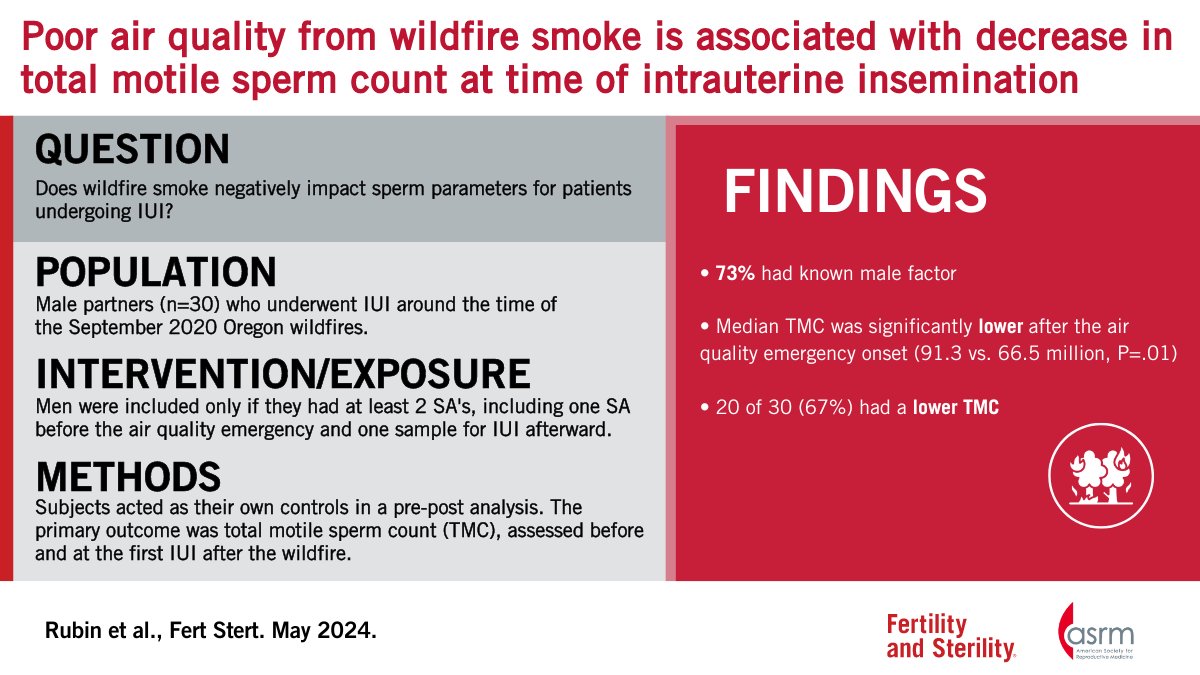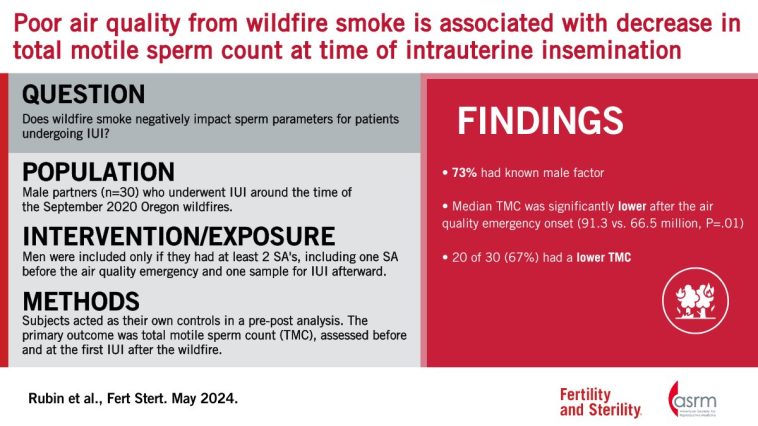
Wildfire Smoke and Home Health: An Unwelcome Visitor Affecting More Than Our Structures
Recent research has spotlighted a surprising and concerning issue: wildfire smoke may be damaging male fertility. Although the initial study focused on reproductive health, the implications of this research extend well beyond the realm of personal health, touching on home improvement, outdoor yard care, and maintaining a safe living environment. As homeowners and service experts, it’s important to appreciate how environmental hazards like wildfire smoke can affect not only our health but also the comfort and safety of our homes.
While wildfire smoke has long been known for its effects on respiratory health and its association with conditions such as lung cancer and heart disease, the study published in the journal Fertility and Sterility introduces a new layer of complexity. Researchers monitored sperm quality during major wildfire smoke events in the Seattle area. With declines noticed in sperm concentration, total count, and mobility—all critical measures for fertility—the study raises questions about lasting environmental impacts that may extend into the domestic sphere.
Understanding the Tricky Parts of Wildfire Smoke Exposure
The research reveals some tangled issues regarding what happens when wildfire smoke drifts into our living spaces. The study primarily examined semen samples from 84 men undergoing fertility treatments during periods marked by significant wildfire events. The results suggest that exposure to the fine, particle-laden smoke has a measurable effect on the quality of sperm. Such findings underscore that environmental exposures are not only a health hazard but can also lead to long-term repercussions, some of which we are only beginning to understand.
In our everyday lives, we might think of wildfires as unpredictable events that only influence the outside world. However, the small particles and toxic substances in the smoke easily find their way indoors, infiltrating every nook and cranny of our homes. From clogged air filters to compromised indoor air quality, the presence of wildfire smoke becomes a multifaceted challenge—one that calls for a careful evaluation of both our homes and our health routines.
Wildfire Smoke Impact on Indoor Air Quality
For homeowners and property managers, the quality of indoor air is key to both personal well-being and maintaining home value. When wildfire smoke infiltrates houses, it brings along hazardous particles that can affect not only respiratory systems but, as research indicates, even reproductive health. Here are some bullet points to consider regarding the effect of smoke indoors:
- Fine particulate matter can settle on furniture and surfaces, leading to long-term contamination.
- Airborne toxins may require advanced filtration systems to filter out effectively.
- The presence of smoke can exacerbate pre-existing conditions in individuals sensitive to air pollutants.
- Exposure problems may extend to pets and outdoor plants as well, impacting overall home life.
Homeowners can take proactive steps to improve their indoor air quality during wildfire seasons. Investing in high-quality air purifiers, replacing HVAC filters regularly, and ensuring proper ventilation are all effective strategies to keep the indoor environment as safe as possible from airborne toxins.
Steps to Bolster Your Home’s Defenses Against Environmental Threats
While the study highlights a more personal health risk, the notion of wildfire smoke invading our immediate living spaces has implications for home security and maintenance. As wildfires become more frequent and intense, modern homeowners must figure a path through protecting property and family health. Consider these key strategies:
- Air Filtration and Purification: Upgrading your home’s HVAC system with advanced filters can help capture even the smallest particles from wildfire smoke. Commercial and residential-grade air purifiers are becoming a must-have investment.
- Sealing and Insulation: Ensure that windows, doors, and other potential entry points for air are well sealed. High-quality weatherstripping and insulation not only improve energy efficiency but also act as barriers against external pollutants.
- Regular Maintenance Checks: Regularly inspect your home for any signs of smoke damage. Cleaning ducts and replacing filters sooner rather than later can reduce the overall exposure within your home.
- Landscaping Considerations: Maintain a defensible space around your home. Removing dead vegetation and trimming back overgrown shrubs can slow the spread of wildfires and reduce the risk of smoke infiltration.
Outdoor Yard Care and Sustainability in the Face of Wildfire Threats
While discussions on wildfire smoke often center around immediate health effects and home interior safety, the impact on outdoor spaces is equally significant. For those of us passionate about yard care and outdoor remodeling, wildfire smoke forces us to take a closer look at our outdoor practices and sustainable living strategies.
Enhancing Outdoor Safety and Aesthetic Appeal
Wildfires can disrupt outdoor beauty and safety in a multitude of ways. Homeowners invested in yard improvement must balance aesthetic appeal with practical measures that help mitigate potential environmental hazards. It’s essential to consider the following aspects:
- Plant Selection: Opt for fire-resistant plant species in your landscape. Many native plants have adapted to local conditions and offer a natural shield against wildfire spread.
- Hardscaping Elements: Incorporate stone patios, gravel walkways, or other non-combustible materials into your outdoor design. These hardscapes can serve as both functional spaces and firebreaks during high-risk periods.
- Defensible Space: Maintaining an appropriate clearance between trees, shrubs, and your home is key. The U.S. Fire Administration recommends at least a 30-foot buffer, with reduced vegetation close to the structure.
By making informed decisions about yard care and investing in a landscape that can endure harsh environmental conditions, homeowners can help protect their properties against the consequences of nearby wildfire activity.
Long-Term Environmental Considerations for Homeowners
Wildfire smoke is more than a transient nuisance. It represents a broader environmental challenge that requires careful thought and planning. The study’s findings on fertility may serve as a wake-up call, urging us to adopt proactive measures and stay informed about the subtle details of environmental exposure. Homeowners can work with local authorities and environmental experts to devise strategies that safeguard both property and personal well-being.
The long-term nature of these issues means that we must continuously evaluate our home improvement strategies. Consider the following table that summarizes long-term solutions for both indoor and outdoor protection from wildfire smoke:
| Area of Focus | Suggested Remediation | Key Benefits |
|---|---|---|
| Indoor Air Quality | High-efficiency filtration systems, regular HVAC maintenance, and portable purifiers | Cleaner air, reduced particulate accumulation, improved health conditions |
| Home Sealing and Insulation | Weatherstripping, updated windows, door seals | Minimized pollutant infiltration, energy savings, increased home value |
| Outdoor Landscaping | Fire-resistant plants, defensible space creation, hardscaping solutions | Enhanced property safety, improved aesthetic appeal, reduced wildfire risks |
| Regular Home Maintenance | Periodic checks for smoke damage, duct cleanings, scheduled weatherproofing | Prolonged system life, early detection of issues, overall home durability |
By understanding and working through these practical measures, you can ensure that your home remains a sanctuary, even in times of environmental uncertainty.
Addressing Confusing Bits: The Broader Impact of Environmental Stress
The recent study serves as a stark reminder that environmental hazards like wildfire smoke have far-reaching implications, touching on more personal aspects such as reproductive health. However, these findings also have a ripple effect on community resilience and home life. It’s not only about dealing with immediate health scares—there’s also an ongoing need to figure a path through how we live in an era characterized by unpredictable natural threats.
Understanding the Health and Safety Challenges
Environmental stress, such as that resulting from wildfire smoke, contributes to a range of health challenges. Recognizing the full scope of these challenges means on one hand, staying updated with the latest research, and on the other, implementing effective home remedies and upgrades. The key health and safety takeaways include:
- Health Monitoring: During wildfire seasons, keep an eye on any unusual changes in symptoms such as persistent cough, difficulty breathing, or even subtle changes in personal health markers like reproductive indicators.
- Seeking Professional Guidance: For those undergoing fertility treatments or other health therapies, discuss any potential impacts of environmental exposures with your health provider. Being open about your environment may lead to additional recommendations.
- Integrating Home and Health Improvements: Consider home improvement projects that double as health measures. For instance, installing energy-efficient air purifiers and better insulation not only boosts home efficiency but also contributes to better indoor air quality.
Taking these steps can feel a bit overwhelming at first, but working through the messy bits can ultimately lead to a safer, healthier living experience. While the study itself was not designed to cover all the layers of environmental impact, it opens the door to broader discussions about how we manage our day-to-day exposure to naturally occurring toxins.
Finding Your Path Through the Fine Points of Research and Practical Home Management
The discovery that wildfire smoke might adversely affect male fertility is just one of many subtle details emerging about environmental exposure. It’s crucial for homeowners to integrate this evolving knowledge into everyday practices. After all, a well-maintained home isn’t just about a fresh coat of paint—it’s about understanding and mitigating the small twists and turns that can impact living conditions.
Bridging the Gap Between Scientific Studies and Practical Home Care
Scientific studies such as the one on wildfire smoke and fertility often seem distant from our daily challenges. Yet, there is a direct line between environmental health research and effective home management. As homeowners, we can take proactive steps by reminding ourselves that:
- Research is a valuable tool: Keep up with local news and scientific studies to understand the potential impacts of natural phenomena on your property and well-being.
- Home improvements can create a healthier living environment: Upgrading your air filtration system, reinforcing structural seals, and creating defensible spaces in your yard are practical actions that can lead to noticeable improvements.
- Sustainable Choices Matter: Choosing sustainable materials and environmentally friendly practices not only protects your home but also contributes to broader environmental health.
Incorporating these practical measures can seem like working through a nerve-racking list of tasks. Yet, when approached step by step, these updates ultimately add to your family’s safety and your home’s long-term value.
Home as a Sanctuary: Balancing Improvement Projects with Health Precautions
Your home should be a refuge from the stressful and often intimidating challenges of the outside world—especially when natural hazards like wildfire smoke are becoming more common. Balancing the need for regular home improvement projects with health precautions is a dynamic process that requires attention to the little facts. For example:
- Regular Inspections: Schedule periodic inspections of both indoor air quality and outdoor landscapes. This proactive approach ensures that any signs of deterioration or smoke infiltration are caught early.
- Integrated Home Upgrades: When remodeling or upgrading, consider elements that enhance safety. For instance, installing energy-efficient windows can provide superior sealing against airborne pollutants while also reducing energy costs.
- Outdoor Design with a Purpose: When planning yard projects, think about how landscaping choices can serve as firebreaks or barriers that minimize smoke penetration.
This balanced approach—where health and home improvement go hand in hand—is critical in an age where external environmental pressures can suddenly disrupt our domestic comfort. By managing these aspects together, homeowners can enjoy a more stable and secure living space.
Working Through Home Improvement Challenges During Wildfire Seasons
Many homeowners have experienced the mixed feelings of wanting to enhance their properties while also contending with the oppressive effects of wildfire smoke. The challenges are often full of problems, loaded with issues, and sometimes intimidating in their scope. However, a strategic approach can help mitigate these difficulties over the long run.
Practical Home Security Upgrades Against Environmental Intrusions
When wildfire smoke becomes a regular visitor, the same sort of diligent upkeep required for home security and maintenance can be applied. Here are some practical steps that can be taken to bolster your home’s defenses:
- Install Advanced Air Filtration Systems: Consider systems with HEPA filters that effectively trap fine particles. These systems can be integrated with your home’s existing HVAC to maintain cleaner air during high-smoke periods.
- Apply Weatherproof Seals: Work with a trusted contractor to inspect and upgrade all door and window seals. This is a cost-effective measure that offers immediate relief from smoky intrusions.
- Upgrade Insulation: Modern insulation solutions do more than keep houses warm—they also act as an invaluable barrier to external pollutants. Investing in energy-efficient insulation can pay dividends in both comfort and safety.
- Routine Maintenance Procedures: Develop a checklist for regular maintenance during wildfire seasons. This may include cleaning gutters, replacing filters, and inspecting ventilation ducts for any signs of buildup.
Each of these steps not only enhances your home’s security but also adds a layer of comfort that comes from knowing you are doing everything possible to create a safe haven for your loved ones.
Long-Term Home Improvement Planning in an Uncertain Environment
Home improvement is not merely an occasional project—it’s an ongoing process that adapts to environmental changes. As the research on wildfire smoke and health outcomes unfolds, it becomes clear that long-term planning is essential. Consider these long-term planning tips:
- Stay Informed: Follow local news, research studies, and weather forecasts to understand when your area might be at risk for wildfire smoke events.
- Regularly Update Systems: As technology improves, so do methods for securing your home against environmental hazards. Regularly updating your home’s systems, from HVAC to insulation, is a forward-thinking strategy.
- Invest in Sustainable Materials: When remodeling or renovating, opt for sustainable and fire-resistant building materials. These investments can have lasting benefits, both environmentally and economically.
- Create a Contingency Plan: Work with professionals to draft an emergency plan that covers not only evacuations during fires but also the steps to take immediately after exposure to ensure interior environments are quickly restored.
Planning for the long haul ensures that even during periods of environmental tension, your home remains a sturdy base for everyday life. Working through the little details now can save a host of nerve-racking issues in the future.
Environmental Health Research: Connecting Dots for Better Home Living
While the primary focus of the study was on male fertility, the broader message from environmental health research is clear: external environmental exposures have hidden complexities that impact us in unexpected ways. It’s an invitation to poke around and take a closer look at how external pollutants—whether they affect our reproductive health, skin integrity, or even the durability of our properties—warrant preventive measures.
Diving In: The Importance of Comprehensive Environmental Research
One of the key takeaways from this research is the necessity to systematically examine the many fine points of environmental exposure. This means consulting experts, staying updated with research, and integrating new findings into our home improvement strategies. A few reasons to embrace this approach include:
- Preventive Action: Early knowledge of environmental risks allows homeowners to take proactive measures. For example, understanding the impact of airborne particulates can lead to updating HVAC systems sooner rather than later.
- Healthy Habits: Incorporating research into everyday routines can lead to healthier lifestyles. Whether it’s investing in better air purifiers or simply staying indoors during heavy smoke events, informed choices matter.
- Holistic Safety: Going beyond immediate fixes, integrating research into comprehensive home management provides a well-rounded strategy for safety and comfort.
By diving in and taking a closer look at how environmental conditions affect both our homes and our bodies, we can piece together a strategy that supports long-lasting wellness and property resilience.
Bringing It Together: A Unified Approach to Home and Health Conservation
In many ways, the study on wildfire smoke is a microcosm of larger environmental issues that affect all aspects of life, from personal health to home security. A unified approach that combines home improvement with health awareness is essential. Here are some ways to integrate these perspectives:
- Create Multi-Layered Defense Systems: This might include a combination of advanced air filtration, sealed home envelopes, and strategic outdoor landscaping that all contribute to reducing environmental impact.
- Emphasize Regular Updates: Both your home systems and your understanding of environmental risks require regular updates. This dual focus ensures that as conditions change, you remain equipped to handle newer challenges.
- Cross-Disciplinary Solutions: Don’t hesitate to consult with professionals from diverse fields—health experts, environmental scientists, home improvement contractors—to create solutions that address both the indoor and outdoor challenges posed by wildfire smoke.
Bringing together these different aspects demonstrates that the work required to maintain a safe home is not just about aesthetics or functionality—it’s about safeguarding the well-being of everyone who lives within those walls.
Taking the Wheel: Practical Strategies to Weather Wildfire Smoke
Even as research continues to unearth more about the ways in which wildfire smoke affects health, homeowners are empowered with practical measures to protect their families and property. This means taking the wheel and steering through each of the challenges presented by these environmental threats.
Emergency Preparedness and Home Upgrades
When dealing with unpredictable wildfire events, having a clear plan is essential. Consider assembling an emergency preparedness kit that includes:
- High-quality face masks designed to filter small particles
- A portable air purifier for immediate indoor relief
- Extra HVAC filters and cleaning supplies
- A toolkit for quick sealing of window and door gaps
Alongside this kit, a comprehensive home upgrade strategy can alleviate nerve-racking worries. Routine checks on your HVAC system, windows, and insulation aren’t just maintenance tasks—they’re investments in your family’s well-being during critical times.
Community Collaboration and Local Resources
No homeowner is an island. When wildfire smoke or other environmental issues rear their head, collaboration with neighbors and local organizations can lighten the load. Here are a few ideas for community involvement:
- Neighborhood Air Quality Monitoring: Share information and tools that can help track smoke levels, ensuring everyone stays informed.
- Local Workshops: Attend or even organize workshops on emergency preparedness, home sealing, and sustainable landscape options.
- Shared Resources: Pool resources for bulk purchases of air purifiers and filters, or negotiate group discounts with local service providers.
Working together not only strengthens community bonds but also ensures that everyone is better equipped to manage the occasional air quality dips and their impacts at home.
Looking Ahead: Research, Resilience, and Homeowner Empowerment
As scientists dig into the effects of wildfire smoke on reproductive and overall health, the findings serve as a key indicator that environmental exposures are a critical, albeit often hidden, part of our everyday lives. For homeowners, this research reinforces the need for a multidimensional approach to maintaining a healthy, secure, and resilient living space.
What Homeowners Can Expect in the Coming Years
Based on emerging research and environmental patterns, homeowners should be prepared for several ongoing trends:
- Increased Research and Awareness: More studies will likely emerge linking environmental pollutants to various health outcomes. Staying informed will become even more essential.
- Advances in Home Improvement Technology: Expect more sophisticated air cleaning systems, smarter HVAC integrations, and innovations in window sealing and insulation design.
- Adaptive Landscaping Techniques: As fire-resistant and sustainable landscaping becomes more mainstream, homeowners will find a larger range of options designed specifically for wildfire-prone areas.
- Community and Regulatory Engagement: Local governments and community bodies may implement new standards or resources dedicated to reducing environmental risks for residents.
These trends suggest a future where environmental challenges are met with inventive solutions—a future in which homeowners and communities work together to figure a path through even the most intimidating external threats.
Empowering Homeowners through Informed Choices
The evolving research is a double-edged sword: on one hand, it introduces new challenges; on the other, it empowers us with the knowledge needed to make better decisions. In this context, every upgrade to your home—be it an improved air filtration system, a re-landscaped yard, or reinforced entry seals—represents a proactive stride toward long-term safety.
With wildfire smoke increasingly becoming a recurring issue, the integrated approach of combining health insights with practical home improvement measures offers a blueprint for future resilience. Each small adjustment can lead to significant benefits, ensuring that your home remains a safe haven capable of withstanding both environmental stresses and personal health challenges.
Final Thoughts: Home Maintenance in an Era of Environmental Change
Wildfire smoke’s subtle yet measurable impact on male fertility is a wake-up call—an invitation to take a closer look at how our environment and our homes interact. The intricate, and sometimes intimidating, relationship between external pollutants and domestic safety calls for a well-rounded response. As we work through the tangles of maintaining our homes in an era of environmental threat, it’s important to remember that the key pieces of staying safe lie in proactive measures, informed decisions, and community collaboration.
By integrating enhanced air quality systems, upgrading insulation, and creating defensible outdoor spaces, we can not only shield ourselves from immediate hazards but also pave the way for a healthier future. The onus is on homeowners and property managers alike: invest in the small details now so that your home can stand resilient, offering comfort and security even when the air outside is less than ideal.
While research continues to dig into the finer points of wildfire smoke exposure and its various impacts, taking a holistic approach to your home’s maintenance is more critical than ever. In doing so, you’re not just protecting your property; you’re safeguarding your family’s health and well-being—ensuring that the place you call home remains a sanctuary in an increasingly unpredictable world.
Ultimately, the marriage of scientific insight and practical home improvement creates a roadmap for maintaining quality living in the face of environmental challenges. It’s a delicate balance of addressing both the obvious and the subtle details, working through every twist and turn as we adapt our homes to the evolving landscape of modern life.
As we look ahead, let us steer through these environmental challenges with a proactive mindset—leveraging research, embracing home improvement innovations, and strengthening our communities. The cumulative effect of these efforts will not only improve our personal well-being but also enhance the resilience of our neighborhoods, ensuring that every home stands as a testament to preparedness, safety, and enduring comfort.
Originally Post From https://www.usnews.com/news/health-news/articles/2025-10-09/wildfire-smoke-might-damage-male-fertility
Read more about this topic at
Wildfire smoke linked to declines in sperm quality – UW Medicine
OHSU study finds unhealthy air quality from wildfires may …


